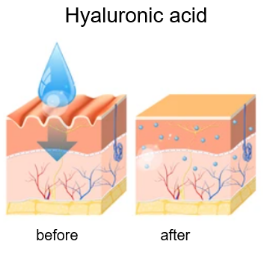Hyaluronic Acid Quality Control Testing Services
Hyaluronic Acid (HA), also known as hyaluronan, is a high molecular weight linear polymer with repeating disaccharide units. Each disaccharide unit contains a D-glucuronic acid and an N-acetyl-D-glucosamine residue linked by a glycosidic bond. It is widely distributed in the human body, especially in the eyes, synovial fluid, and skin. With its unique molecular structure and physical/chemical properties, HA exhibits several important physiological functions, such as lubricating joints, regulating vascular permeability, modulating proteins, and promoting wound healing. More importantly, HA is considered the best moisturizing substance found in nature, often referred to as the ideal natural moisturizing factor (NMF). It can improve skin metabolism, making the skin soft, smooth, and elastic, preventing aging while also acting as an excellent transdermal absorption enhancer.
Currently, HA is widely used in the cosmetics industry, biomedical industry, and others. Therefore, accurate testing of new products containing hyaluronic acid is critical for developing new injectable soft tissue fillers, wrinkle-filling gels, cosmetics, and medical device scaffolds. HA is also used in ophthalmic fluids, parenteral drug formulations, nasal sprays, and aerosols, and is a key active ingredient in products aimed at preventing skin aging (such as viscoelastic supplements). Understanding the quantity, purity, physicochemical properties, chemical composition, and microbiological properties of HA is essential to support research and development, monitor raw material quality, and control the production process.

Skin Changes After Using Hyaluronic Acid
BTP Biotech Laboratory (BTP) follows the regulations and guidelines of NMPA, ICH, FDA, and EMA to develop and validate a set of precise and unique analytical services to control the quality of raw materials and finished products containing hyaluronic acid, based on platforms like ICP-MS, ICP-AES, GC-MS, and IC. We also offer method development and validation, stability studies under controlled temperature and humidity, and extractable and leachable studies. BTP focuses on product quality and safety, helping clients meet and exceed HA product quality, safety, and regulatory standards. BTP's hyaluronic acid quality control tests include the analysis of the following characteristics:
(i) Appearance, shape, color;
(ii) Dosage/concentration of hyaluronic acid;
(iii) Measurement of BDDE (1,4-butanediol diglycidyl ether) and lidocaine hydrochloride content;
(iv) Identification/confirmation of structure;
(v) Stability measurement;
(vi) Measurement of organic volatile impurities and particulates, water content, protein content, residual chemicals or solvents, degradation products;
(vii) Physicochemical properties such as pH, osmolality, viscosity, and particle size;
(viii) Heavy metal analysis;
(ix) Compatibility testing.
BTP Biotech (BTP) is dedicated to providing professional services such as quality control testing and project verification for the biopharmaceutical and medical device industries. The company's laboratories adhere to regulations and guidelines from NMPA, ICH, FDA, and EMA, and are certified by both CNAS and ISO9001 quality systems. We have established a comprehensive quality system with data backup and equipment calibration/verification. Software audit tracking provides integrated solutions and technical services that support the development, registration, and release of biological products. Our hyaluronic acid quality control testing platform provides a series of chemical, biochemical, microbiological, and physicochemical testing services to help you control quality, ensuring the highest quality products that meet regulatory and consumer expectations for safety and efficacy.
Frequently Asked Questions
Question 1: Why is hyaluronic acid analysis important in the medical industry?
BiotechPack, A Biopharmaceutical Characterization and Multi-Omics Mass Spectrometry (MS) Services ProviderHyaluronic acid is a commonly used filler in the medical industry for filling treatments and treating certain eye and joint diseases. Analyzing hyaluronic acid in the medical industry can:
1) Check the quality and purity of hyaluronic acid used in medical products;
2) Evaluate the concentration of hyaluronic acid in medical products to ensure it meets required specifications;
3) Understand the physical and chemical properties of hyaluronic acid: its viscosity, stability, and filling effect. All these characteristics allow it to be optimized in medical products;
4) Evaluate the effectiveness of different types of hyaluronic acid in treating specific conditions during formulation testing.
Therefore, hyaluronic acid analysis can help medical manufacturers ensure their products meet quality and safety standards, optimize formulations for best results, and assess their effectiveness in treating different conditions.
Question 2: Why is hyaluronic acid analysis important in the cosmetics industry?
BiotechPack, A Biopharmaceutical Characterization and Multi-Omics Mass Spectrometry (MS) Services ProviderHyaluronic acid is a popular material in the cosmetics industry due to its moisturizing and anti-aging properties. The cosmetics industry must analyze hyaluronic acid to:
1) Verify the quality and purity of hyaluronic acid used in cosmetic formulations;
2) Measure the concentration of hyaluronic acid in cosmetics to ensure it meets required specifications;
3) Evaluate the effectiveness of different types of hyaluronic acid, including in formulation testing;
4) Understand the physical and chemical properties of hyaluronic acid, such as its molecular weight or size distribution. This allows the cosmetics industry to optimize its formulations in cosmetics.
In other words, hyaluronic acid analysis can help cosmetics manufacturers ensure their products contain the desired active ingredients and optimize their formulations for the best results.
Related Services
Thermal Stability Analysis (DSC)
Infrared Spectroscopy Analysis (FT-IR)
Dynamic Light Scattering Analysis (DLS)
Product-related Impurity Analysis
Process-related Impurity Analysis
Other Process-related Impurity Analysis
How to order?





